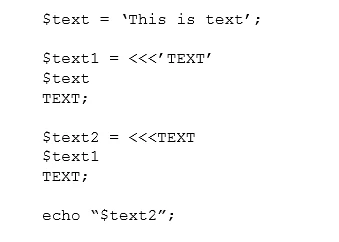Question 6 of 85
You want to parse a URL into its single parts. Which function do you choose?
Correct Answer: A
Question 7 of 85
What is the output of the following code?


Correct Answer: A
The output of the code is 'This is text'. This is because the code uses a 'heredoc' syntax in PHP, which allows the definition of multiline strings. The line $text1 = <<<‘TEXT’ $text TEXT; assigns the value of the variable $text (which is 'This is text') to $text1. Then, $text2 = <<
Question 8 of 85
What function can be used to retrieve an array of current options for a stream context?
Correct Answer: C
Question 9 of 85
Given the following array:

Which function will remove the value 28 from $a?
Which function will remove the value 28 from $a?
Correct Answer: A
Question 10 of 85
When would you use classes and when would you use namespaces?
Correct Answer: A